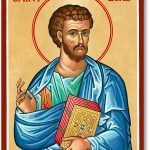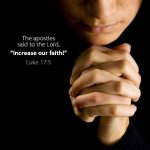Oct 13 Monday: Lk 11:29-32
The Sign of Jonah – Recognizing God’s True Signs
(Luke 11:29–32; cf. Matthew 12:38–42)
Because many false prophets and self-proclaimed messiahs had appeared throughout Israel’s history, the Jewish religious leaders demanded that Jesus perform a spectacular “Messianic sign” to prove His divine authority. Their pride and spiritual blindness prevented them from recognizing the true Messiah standing before them. They dismissed His countless acts of healing, deliverance, and compassion, clear fulfillments of Isaiah’s prophecies about the coming Savior (Isaiah 35:5–6; 61:1).
Jesus’ Rebuke and the Sign of Jonah
In response, Jesus called them “an evil generation” (Luke 11:29) for their hardened hearts and refusal to believe the works of God unfolding before their eyes. He declared that they would receive only “the sign of Jonah.” Just as Jonah spent three days in the belly of the great fish before proclaiming repentance to Nineveh, so the Son of Man would spend three days in the heart of the earth before rising in glory (Matthew 12:40). This “sign of Jonah” pointed to the Resurrection, the greatest and final proof of Jesus’ divine identity.
Jesus also invoked two historical examples to shame His unbelieving audience. The people of Nineveh, who were pagans, repented at Jonah’s preaching and were spared destruction (Jonah 3:5–10). The Queen of Sheba (also known as the Queen of the South) traveled over 2,000 miles from Arabia or Ethiopia to listen to the wisdom of Solomon (1 Kings 10:1–10). Both recognized and responded to God’s revelation in their time, while Israel’s religious leaders rejected the One greater than Jonah and Solomon.
By lifting up Gentiles as models of faith, Jesus revealed that God’s mercy and revelation are not limited to any one people or nation. What matters is the openness of the heart to receive the truth.
Life Messages
- Recognize God’s Signs in the Ordinary:
God continues to communicate His grace through visible and spiritual signs. Every Sacrament is a sacred sign instituted by Christ to give grace (CCC §1131). In Baptism, water becomes the sign of new life; in the Eucharist, bread and wine become the Body and Blood of Christ, the living memorial of His sacrifice (Luke 22:19–20). - See Christ in the People Around You:
Each person we encounter bears the image of God (Genesis 1:27) and becomes a sign of His living presence. The Holy Spirit dwells in every baptized believer, making them temples of God’s presence (1 Corinthians 6:19). - Interpret Life through Faith:
Every event, whether joyful or painful, can reveal God’s hand at work. What seems ordinary or even tragic may conceal divine purpose, calling us to trust in God’s providence (Romans 8:28). - Return to the Living Word:
The Holy Scriptures remain God’s clearest and most enduring sign, offering His living message to every generation (2 Timothy 3:16–17). Instead of chasing after sensational miracles or mystical phenomena, we should seek the deeper signs of His grace in Scripture, Sacraments, and daily life.
In short, faith is not about demanding extraordinary proofs from God, but about recognizing His quiet, constant presence already at work among us. As Jesus said, “Blessed are those who have not seen and yet believe” (John 20:29). God bless you.
References:
- Catechism of the Catholic Church (2nd ed.). (1997). Libreria Editrice Vaticana. §§1131–1134.
- Holy Bible, New Revised Standard Version Catholic Edition. Luke 11:29–32; Matthew 12:38–42; Isaiah 35:5–6; Jonah 3:5–10; 1 Kings 10:1–10; John 20:29.
- Augustine of Hippo. (1888). Sermons on Selected Lessons of the New Testament (NPNF Series 1, Vol. 6). Christian Literature Publishing Co.
Oct 14 Tuesday: Saint Callistus I, pope and martyr: Lk 11:37-41
The Essence of True Religion – Clean Hands or a Clean Heart?
(Luke 11:37–41)
In today’s Gospel, Jesus challenges the hypocrisy of the Pharisees who had reduced religion to a series of ritual observances. When a Pharisee invited Jesus to dine with him, Jesus deliberately omitted the customary handwashing ritual before eating. This ritual, described in rabbinic tradition, required pouring water over one’s hands from fingertips to wrists and back again, symbolizing ceremonial purity. For pious Jews, failure to observe this was considered sinful (cf. Mark 7:3–4). Thus, when Jesus neglected it, His host was shocked.
Jesus Teaches the Essence of Religion
Seizing the moment, Jesus turned the external ritual into a lesson about the interior life. He told His host that true purity is not achieved by water poured on the hands but by grace cleansing the heart. The real defilement comes not from what enters a person from outside, but from what proceeds from the heart, evil thoughts, greed, pride, envy, and arrogance (Mark 7:20–23).
Jesus condemned the Pharisees for their obsession with outward piety while neglecting the inner conversion that God desires. They cleaned the “outside of the cup and dish” but ignored the uncleanness within (Luke 11:39). This rebuke echoed the prophets’ call for interior conversion: “Rend your hearts, not your garments, and return to the Lord your God” (Joel 2:13).
In contrast to ritualism, Jesus pointed to almsgiving as a true expression of a purified heart. Giving to the poor is not merely a good deed, but a manifestation of divine love active in the soul. As St. John Chrysostom taught, “Almsgiving is the queen of virtues, the cure of sin, the source of mercy” (Homilies on Matthew 66). By sharing one’s goods, material, emotional, and spiritual with others, a person imitates God’s mercy and participates in His sanctifying work.
St. John of the Cross beautifully summarized this teaching: “In the evening of life, we will be judged on love.” True holiness, then, lies not in external observance, but in the interior disposition that leads to merciful action.
Life Messages
- Let Faith Produce Works of Love:
Interior purity must manifest in concrete acts of charity. As St. James reminds us, “Faith by itself, if it has no works, is dead” (James 2:17). Every charitable deed becomes an external sign of the heart’s inner union with God. - Repent and Cleanse the Heart:
Before approaching the altar, we are called to purify our hearts through repentance and reconciliation (Matthew 5:23–24). Only then can we offer God true worship “in spirit and in truth” (John 4:24). - Love as the True Mark of Religion:
The authenticity of our faith is proven not by religious display but by our capacity to love others with mercy, respect, and compassion. Love transforms ritual into relationship, and faith into life.
In the end, it is not the water on our hands but the love in our hearts that makes our offering acceptable before God. God bless you.
References:
- Catechism of the Catholic Church (2nd ed.). (1997). Libreria Editrice Vaticana. §§1430–1431, 2447.
- Holy Bible, New Revised Standard Version Catholic Edition. Luke 11:37–41; Mark 7:3–23; Joel 2:13; James 2:17; John 4:24.
- Chrysostom, J. (1888). Homilies on the Gospel of Matthew (NPNF Series 1, Vol. 10). Christian Literature Publishing Co.
- John of the Cross. (1991). The Collected Works of St. John of the Cross (K. Kavanaugh & O. Rodriguez, Trans.). ICS Publications.
Oct 15 Wednesday:Saint Teresa of Avila, virgin and doctor of the Church. Lk 11:42-46
Hypocrisy and the Burden of Religion
Reflection on Luke 11:42–46
In today’s Gospel, taken from Luke’s account of the Sermon on the Plain, Jesus expresses deep moral indignation and sorrow at the hypocrisy of the scribes and Pharisees. These religious leaders, instead of guiding people toward God, have built barriers that weigh heavily upon them. Through unnecessary, impractical, and endless interpretations of Mosaic law, they have turned divine worship into a burden rather than a blessing.
Jesus makes three specific accusations against them, naming their misbehaviors clearly and directly.
1. Misinterpreting the Spirit of the Law
The first charge is that they have distorted God’s Law, focusing on legalistic precision rather than spiritual intent. As Jesus says, “Woe to you Pharisees! For you tithe mint and rue and every herb, and neglect justice and the love of God” (Luke 11:42). The Law of tithing was meant as an expression of gratitude to a generous and providing God (see Deuteronomy 14:22; Leviticus 27:30). But the Pharisees made it burdensome by counting even the smallest garden herbs while neglecting mercy, justice, and love. In doing so, they lost sight of the very heart of God’s will.
2. Seeking Status and Honor
The second accusation concerns their pride and desire for public recognition. They loved places of honor in synagogues and respectful greetings in marketplaces (Luke 11:43). Their religiosity became a performance for human praise rather than a humble service before God. St. John Chrysostom once observed that “the love of honor is like a disease that corrupts even good works” (Homilies on Matthew, 72.1). Jesus reminds us that the true disciple seeks not applause but faithfulness.
3. Moral Corruption Behind Religious Appearances
Finally, Jesus compares them to “unmarked graves” that people walk over without knowing (Luke 11:44). This image is powerful: on the roads leading to Jerusalem, tombs were whitewashed before major feasts to prevent accidental ritual defilement. Outwardly, the Pharisees appeared pure and spotless, but inside they were full of spiritual decay. Their hypocrisy contaminated others, spreading false ideas about what God truly demands mercy, humility, and love rather than rigid external observance.
Life Messages
1. True Religion Is Love in Action
The essence of religion is not in rituals or legalism but in loving God and discovering His image in every person. Genuine love is sacrificial. It lifts the burdens of others instead of adding to them. As St. James writes, “Religion that is pure and undefiled before God is this: to care for orphans and widows in their distress and to keep oneself unstained by the world” (James 1:27).
2. Reverence and Respect Are the Foundations of Faith
The Ten Commandments rest on two great principles: reverence for God and respect for neighbor. When we learn to honor God’s name, His day, and His image in others, we live true religion. Hypocrisy, on the other hand, empties worship of its power. God does not seek performance but sincerity hearts that reflect His justice and mercy.
References
- The Holy Bible, New Revised Standard Version Catholic Edition (NRSVCE)
- Catechism of the Catholic Church, nos. 578–580 (on the Law and Gospel)
- St. John Chrysostom, Homilies on Matthew, 72.1
- Pope Francis, Gaudete et Exsultate (2018), nos. 25–26, on authentic holiness
- Deuteronomy 14:22; Leviticus 27:30; Luke 11:42–46; James 1:27
Oct 16 Thursday:Saint Hedwig, religious & Saint Margaret Mary Alacoque, virgin. Luke 11:47-54
The Hypocrisy of the Pharisees and the Danger of Blocking Others from God
Reflection on Luke 11:47–54
Today’s passage from Luke chapter 11 continues Jesus’ prophetic denunciation of the scribes and Pharisees. According to Matthew’s Gospel (Matthew 23:29–36), Jesus made these accusations on the third day of what we now call Holy Week, while teaching in the Temple courts of Jerusalem. His words expose two forms of hypocrisy that distort religion and hinder people from truly knowing God.
1. Hypocrisy in Honoring the Prophets While Rejecting Their Message
Jesus condemned the hypocrisy of the scribes and Pharisees who built and decorated tombs for the prophets their ancestors had killed. Outwardly, they appeared to venerate these holy men, but inwardly, they shared the same rebellious spirit that had resisted the prophets’ call to conversion. As Jesus said, “Woe to you! For you build the tombs of the prophets whom your ancestors killed. So you are witnesses and approve of the deeds of your ancestors” (Luke 11:47–48).
Abel’s murder by Cain (Genesis 4:8) was the first recorded act of violence against the innocent in Scripture, and Zechariah’s death (2 Chronicles 24:20–22) marked one of the last in the Jewish canon. As the Navarre Bible Commentary explains, “The murder of Abel and that of Zechariah were, respectively, the first and last murders reported in these books which the Jews regarded as Sacred Scripture” (The Navarre Bible: St. Luke, 2003). By referring to these two figures, Jesus symbolically encompassed the entire history of Israel’s rejection of God’s messengers.
Their guilt reached its climax when the religious leaders conspired to crucify Jesus Himself, the very Son of God and the fulfillment of all the prophets. In doing so, they repeated the sins of their ancestors, proving that their external acts of piety were empty gestures devoid of true repentance.
2. Shutting the Door of Knowledge
Jesus’ second accusation was directed at the scribes, the legal experts responsible for interpreting the Scriptures. He declared, “Woe to you lawyers! For you have taken away the key of knowledge. You did not enter yourselves, and you hindered those who were entering” (Luke 11:52).
The scribes were entrusted with what was traditionally called the “office of the keys”—the authority to interpret and teach God’s Law. Yet instead of opening the way to divine truth, they complicated it with endless regulations and obscure interpretations that alienated ordinary believers. By their rigidity and self-interest, they effectively closed the door to God’s wisdom, turning faith into a system of control rather than liberation.
The Catechism warns against this same danger, noting that “the Church’s pastoral activity must always be directed to the salvation of souls and not the imposition of burdens” (cf. CCC 888–890). True spiritual authority opens hearts to the mercy and truth of God; false authority hides Him behind rules and pride.
Life Message
1. Be People of Integrity, Not Hypocrisy
Christ calls us to authenticity in faith. Holiness is not about outward appearances or religious display but about inner conversion and humility. Jesus desires truth in the heart, not empty ritual (cf. Psalm 51:6). If we claim to follow God but harbor pride or duplicity, we resemble those who built tombs for the prophets while killing the living word of God within themselves.
Let us, then, strive for integrity and humility—acknowledging that every good deed we do is by God’s grace. As St. Augustine reminds us, “God resists the proud but gives grace to the humble” (Sermon 117). Holiness begins when we give God the credit for the good He works through us. God bless you.
References
Genesis 4:8; 2 Chronicles 24:20–22; Luke 11:47–54; Matthew 23:29–36; Psalm 51:6
The Holy Bible, New Revised Standard Version Catholic Edition (NRSVCE)
The Navarre Bible: St. Luke (Four Courts Press, 2003), commentary on Luke 11:47–51
Catechism of the Catholic Church, nos. 888–890
St. Augustine, Sermon 117
Oct 17 Friday:Saint Ignatius of Antioch, bishop and martyr: Lk 12:1-7
Beware the Leaven of Hypocrisy
Reflection on Luke 12:1–7
In this passage, Jesus continues His strong rebuke of the hypocrisy of the scribes and Pharisees, comparing it to leaven or yeast. In Jewish tradition, yeast was often viewed as a symbol of corruption because it works unseen, slowly fermenting and spreading through the entire batch of dough. For this reason, the Law of Moses prescribed that all offerings to God be made with unleavened bread (cf. Exodus 12:15; Leviticus 2:11). During the Feast of Unleavened Bread, the Israelites removed every trace of yeast from their homes as a sign of purity and separation from sin.
Jesus uses this familiar image to warn His followers that the teaching and behavior of the Pharisees were like leaven—appearing harmless at first but corrupting hearts and communities from within. Their hypocrisy was not merely personal weakness but a spiritual contagion that misled others. They professed holiness in public yet harbored pride, greed, and self-righteousness in their hearts. As Jesus later said, “Woe to you, scribes and Pharisees, hypocrites! For you clean the outside of the cup and of the plate, but inside they are full of greed and self-indulgence” (Matthew 23:25).
By using the metaphor of yeast, Jesus teaches that hypocrisy spreads quietly but powerfully. The example of a leader who preaches virtue but fails to live it can do more harm than open sin, for it blinds people to the truth and breeds cynicism toward genuine faith. Hence, Christ warns that such duplicity will not remain hidden forever, for “nothing is covered up that will not be uncovered, and nothing secret that will not become known” (Luke 12:2). As the Catechism reminds us, “Christ is the Lord of eternal life… and the conduct of each one and the secrets of hearts will be brought to light” (CCC 678).
The Hidden Made Known
According to the Navarre Bible Commentary, houses in first-century Palestine were often built with flat roofs that served as terraces where families and neighbors gathered to talk and relax during the heat of the day. Words spoken privately in such casual settings easily spread across the village by nightfall. Jesus draws on this familiar image to remind His disciples that all hidden actions and whispered intentions will eventually be revealed by God’s justice. Just as gossip travels from rooftop to rooftop, so too will every concealed hypocrisy be made known before heaven.
This warning, however, is not meant to inspire despair but to call for sincerity and repentance. God’s justice is not vengeful but restorative, uncovering sin so that truth may heal what falsehood has damaged.
Reverential Fear of God
Jesus then turns to the theme of holy fear, contrasting it with the fear of men. “Do not be afraid of those who kill the body and after that can do nothing more. But fear Him who, after He has killed, has authority to cast into hell” (Luke 12:4–5). This fear of God is not the dread of a slave before a cruel master but the reverent awe of a child before a loving Father. The Church distinguishes between servile fear (fear of punishment) and filial fear (fear of offending love). The latter is born of deep reverence and gratitude for God’s goodness and providence.
Nothing, Jesus assures us, escapes the gaze of our heavenly Father not even a sparrow falls without His knowledge (Luke 12:6). Therefore, we should trust Him completely. Our faithfulness, our hidden sacrifices, and even our silent sufferings are all seen by God and will be rewarded in eternity.
Life Messages
1. Practice Transparency and Integrity
Followers of Christ must not imitate the hypocrisy of the Pharisees. Christian witness is credible only when words and actions align. The world does not need perfect disciples, but sincere ones whose honesty and humility make visible the transforming power of grace.
2. Live in Reverential Fear of God
Let our choices reflect the awareness that God sees the heart. The holy fear that Jesus calls us to is rooted in love, an eagerness to please our Father rather than offend Him. As St. John Chrysostom wrote, “When we fear to sin because we fear to grieve Him who loves us, then our fear is holy” God bless you.
References
- The Holy Bible, NRSVCE – Luke 12:1–7; Matthew 23:25; Exodus 12:15; Leviticus 2:11
- Catechism of the Catholic Church, no. 678
- The Navarre Bible: St. Luke (Four Courts Press, 2003), commentary on Luke 12:1–7
- St. John Chrysostom, Homilies on Matthew 43
Oct 18 Saturday: Saint Luke, evangelist. Lk 10:1-9
St. Luke the Evangelist – Apostle of Mercy and the Gentiles
Background and Identity
St. Luke was a Syrian Greek from Antioch, a major city in ancient Syria, known for its culture and learning. Born a Gentile, he converted to Christianity and became a devoted companion and disciple of St. Paul. Scripture identifies him as a physician (Colossians 4:14), and tradition holds that he also possessed artistic skill, which some believe is reflected in his vivid narrative style and attention to detail. Ancient Christian tradition even credits him with painting the first icon of the Blessed Virgin Mary, a copy of which can still be seen in Santa Maria Maggiore in Rome (Butler, 1956).
Luke’s education in Greek culture and philosophy, combined with his exposure to Hebrew Scripture, made him uniquely suited to bridge the gap between Jewish and Gentile believers. He could read the Septuagint (the Greek translation of the Hebrew Scriptures) and was likely conversant in Aramaic, the common language of Palestine. His intellectual and cultural background gave him a universal outlook that shaped his theology and Gospel narrative.
A Prolific Writer of the Gospel and Acts
Luke is the only non-Jewish Evangelist and the author of both the Gospel according to Luke and the Acts of the Apostles (cf. Luke 1:1–4; Acts 1:1–2). These two works form a unified two-volume account addressed to Theophilus, possibly a real person or a symbolic name meaning “friend of God.” Scholars date Luke’s writings between 70 and 85 A.D. Together, they comprise the largest portion of the New Testament, longer even than all the Pauline letters combined (Brown, 1997).
In Christian art, Luke is symbolized by the ox or calf, one of the four living creatures in Ezekiel’s vision (Ezekiel 1:10; Revelation 4:7). The ox represents sacrifice, service, and strength, reflecting Luke’s portrayal of Jesus as the priestly Savior who offers His life for all humanity. Luke begins his Gospel with the priestly service of Zechariah in the Temple (Luke 1:5–25), signaling that the new covenant of mercy is emerging from within Israel’s worship.
Luke is often called the Evangelist of Mercy, emphasizing Jesus’ compassion, forgiveness, and inclusion of the poor, women, and sinners. His parables, the Good Samaritan, the Prodigal Son, and the Lost Sheep are unique to his Gospel and reveal the heart of Christ’s mission: “The Son of Man came to seek and to save the lost” (Luke 19:10).
Companion of St. Paul and the Apostles
The Acts of the Apostles and Paul’s letters provide glimpses into Luke’s life and ministry. He accompanied St. Paul on his missionary journeys through Asia Minor, Greece, and Rome, often using the “we” narrative to indicate his presence (Acts 16:10–17; 20:5–15; 21:1–18; 27:1–28:16). Luke remained faithful to Paul even during imprisonment in Caesarea and Rome, as Paul testifies: “Only Luke is with me” (2 Timothy 4:11). Tradition holds that Luke was also close to Mary, the Mother of Jesus, and drew from her testimony when writing about the infancy of Christ (Luke 1–2).
According to early Christian writers like Eusebius of Caesarea and St. Jerome, Luke lived to an old age, dying in Boeotia, Greece, at about eighty-four years old, having written his Gospel around the age of seventy-four (Ecclesiastical History, III.4).
Life Messages
1. Be Apostles of Prayer
St. Luke’s Gospel portrays Jesus as a man of deep prayer. From His baptism (Luke 3:21) to His agony in Gethsemane (Luke 22:41–46), Jesus is constantly seen communing with the Father. Luke alone records that Jesus spent the night in prayer before choosing His apostles (Luke 6:12) and prayed for Peter’s faith not to fail (Luke 22:32). As Luke shows, genuine discipleship flows from prayer, which aligns the human heart with God’s will.
2. Be Apostles of Mercy and Compassion
Luke presents Jesus as the Savior who brings good news to the poor, freedom to captives, and healing to the broken (Luke 4:18–19). His Gospel elevates women, Samaritans, and sinners, reminding us that no one is beyond the reach of divine mercy. In the spirit of Luke, Christians are called to become the voice of the voiceless, to extend compassion to the forgotten, and to embody God’s preferential love for the poor and marginalized.
As Pope Francis notes, “Mercy is the beating heart of the Gospel” (Misericordiae Vultus, 2015, no. 12). Luke’s life and writings invite us to let that heart of mercy pulse through our words, actions, and ministry. God bless you.
References
Pope Francis. (2015). Misericordiae Vultus [Bull of Indiction of the Extraordinary Jubilee of Mercy]. Vatican City.
Brown, R. E. (1997). An Introduction to the New Testament. Doubleday.
Butler, A. (1956). Lives of the Saints (Vol. 10). Christian Classics.
Catechism of the Catholic Church (2nd ed.). (1997). Libreria Editrice Vaticana.
Eusebius of Caesarea. (1999). Ecclesiastical History (Book III). Trans. A. C. McGiffert. Nicene and Post-Nicene Fathers, Series II, Vol. 1. Christian Literature Publishing Co.













Very powerful and inspiring message
God bless you Catechist